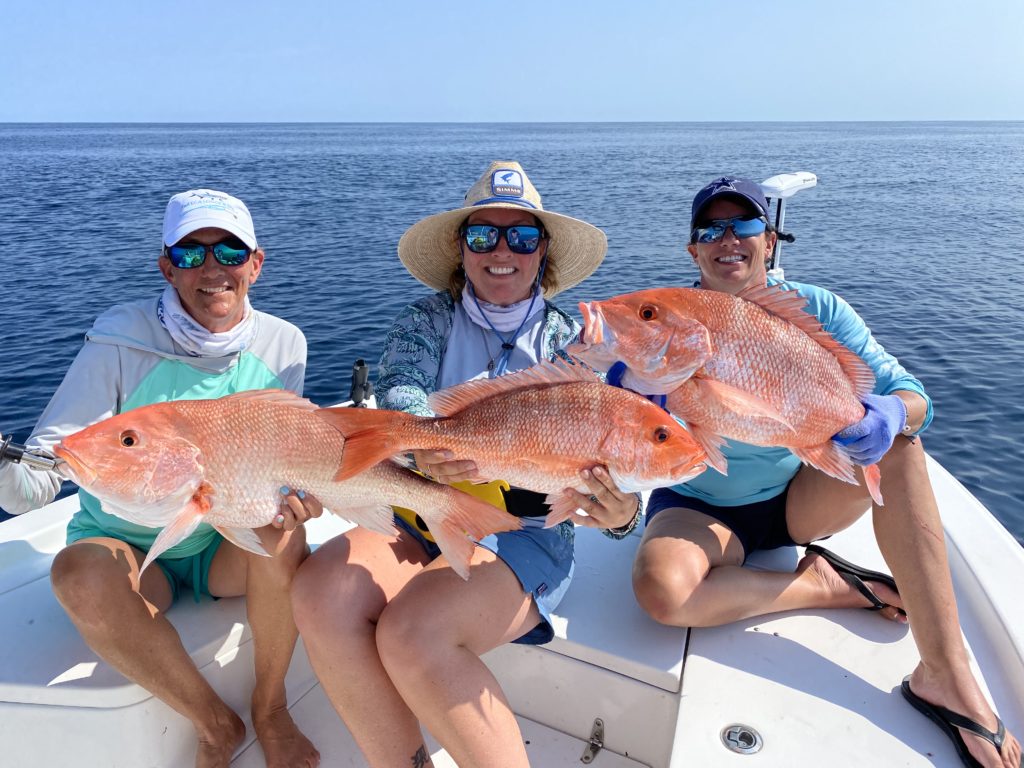
Photo courtesy of Jen Thomasson
Frustrated anglers feel like they are shouting into the wind
Washington, D.C. – May 23, 2022 – On May 20, NOAA Fisheries announced recreational anglers from North Carolina to Florida will have only two days to fish for red snapper in South Atlantic federal waters in 2022. Recreational anglers on private vessels and for-hire vessels will be allowed to keep one red snapper per person per day on Friday, July 8, and Saturday, July 9.
Frustrated anglers say the red snapper is the easiest-caught fish in the Atlantic Ocean, and it is nearly impossible to get bait past these voracious feeders to reach deeper reef fish species. (Watch this video of red snapper in the South Atlantic feeding on top the water.) Over the last decade, anglers have been baffled by NOAA Fisheries’ decision to radically limit public access to red snapper despite the plentiful number of fish they are encountering on the water. In the last 12 years, the recreational sector has been allowed to harvest red snapper in South Atlantic federal waters a cumulative total of 44 days despite increasing abundance of fish.
“The two-day South Atlantic recreational red snapper season is a prime example of the absolute failure by NOAA Fisheries to collect sound data on recreational fisheries and apply adaptive management to a stock that is rebuilding faster than anticipated. While the South Atlantic Council and Congress are working to obtain better data, we are years away from those efforts bearing fruit,” said Jeff Angers, president of the Center for Sportfishing Policy. “Recreational anglers are doing their part to reduce discard mortality and participate in the management process. It’s beyond time for the federal government to do its part to facilitate better data for more informed management decisions.”
In 2020, recreational anglers successfully advocated for the use of descending devices (Amendment 29) to reduce the mortality rate of prized reef fish such as snapper and grouper. When deep-water fish are brought rapidly to the surface, they experience barotrauma – a condition where a buildup of gas pressure in their bodies makes it difficult or impossible to swim back down. If a fisherman releases the fish due to size, season or bag limit restrictions and the fish does not survive, this is a dead discard or wasted fish. A descending device is a weighted hook, lip clamp, or box that will hold the fish while it is lowered to a sufficient depth to recover from the effects of barotrauma and release the fish.
The rule went into effect on July 15, 2020, requiring descending devices be on board all commercial, charter vessels and headboats (for-hire), and private recreational vessels while fishing for or possessing snapper-grouper species. This measure compliments other requirements to increase post-release survival: the use of non-offset, non-stainless steel circle hooks when fishing for snapper-grouper species with hook-and-line gear and natural baits north of 28° N latitude; and all hooks be non-stainless steel when fishing for snapper-grouper species with hook-and-line gear and natural baits throughout South Atlantic federal waters.
Despite these requirements and the increasing use of best fishing practices by anglers, scientist advisors to the South Atlantic Council believe most of the fishing mortality for South Atlantic red snapper is now caused by dead discards. Therefore, allowable harvest must continue to be severely restricted. However, there is no reliable and validated estimate of the magnitude of recreational or commercial fishing discard mortality in the South Atlantic red snapper fishery, and there are no data on the number of fish surviving release since the implementation of Amendment 29. Increasing use and efficacy of descending devices is not yet considered in setting catch limits.
“Saltwater anglers annually spend more than $7.8 billion on fishing trips and durable goods in the South Atlantic,” Angers continued. “Experts believe current abundance of South Atlantic red snapper is the highest it has been since the 1960s. Yet anglers are caught in a vicious cycle of a management regime based on guesses that is penalizing the success of this rebuilding stock.”
In 2021, U.S. Representatives John Rutherford (R-Fla.) and Stephanie Murphy (D-Fla.) led a bipartisan effort to fund a $3.3 million study on the South Atlantic red snapper fishery. The 30-month project, modeled after the Gulf of Mexico “Great Red Snapper Count,” will estimate the number of red snapper over a wide-ranging area, including habitats that are not currently targeted by traditional fisheries surveys. How NOAA Fisheries will incorporate those results is yet to be seen.








